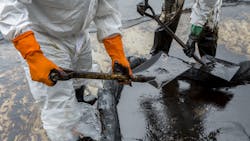Gulf Faces Lasting Impact From Spill
For decades scientists believed that oil spills did most of their damage in the first few weeks, as oil coated animals, plants and terrain.
Even today, to most observers it seems that nature bounces back very quickly from such disasters, as birds and fish repopulate affected areas and evidence of oily deposits on beaches and rocks soon disappears.
But disasters such as the Bouchard 65 barge spill near Cape Cod in 1974, Amoco Cadiz in France in 1978, the Ixtoc 1 well blowout in the Gulf of Mexico in 1979 and the 1989 Exxon Valdez oil spill in Alaska have given scientists a chance to carry out longer-term investigations.
In particular, the Exxon Valdez spill has generated a wealth of research into how such events affect ecosystems. One of the key findings is that sub-lethal biological effects, particularly those associated with reproduction, best predict the long-term impacts that still are apparent in herring, salmon and the region's many other aquatic species.
Now, similar findings are emerging from a combined field and laboratory study carried out by a research team at Louisiana State University (LSU), Baton Rouge, La., into the impact that last year's Deepwater Horizon drilling disaster is having on marsh fish species in the Gulf of Mexico.
The research team is headed by LSU associate professors of biological sciences Fernando Galvez and Andrew Whitehead, with additional inputs from scientists at the department of chemistry and biochemistry at Texas State University, San Marcos, Tex., and the department of biological sciences at Clemson University, Clemson, S.C. Funding for the work was provided by the National Science Foundation, the National Institutes of Health, and the Gulf of Mexico Research Initiative.
In the September 21, 2011, issue of the Proceedings of the National Academy of Sciences (www.pnas.org/cgi/doi/10.1073/pnas.1109545108), the team reports on a four-month field study monitoring the biological effects of oil exposure on fish in the Gulf's coastal marsh habitats. The researchers used killifish as the model species because they are among the most abundant vertebrate animals in those marshes.
The team sampled multiple tissues from adult killifish from each of six field sites during three periods spanning the first four months of the spill. They then compared biological responses across time (before, at the peak, and after oiling) and across space (oiled sites and not oiled ones) and integrated responses at the molecular level using genome expression profiling with complementary protein expression and tissue morphology.
The researchers characterized genome expression profiles for livers because that organ is internal and integrates xenobiotic effects from multiple routes of entry (gill, intestine and skin), and because liver is the primary tissue for metabolism of toxic oil constituents. The team also characterized tissue morphology and expression of CYP1A protein, a common biomarker for exposure to select polycyclic aromatic hydrocarbons, for gills, the organ that provides the greatest surface area in direct contact with the surrounding aquatic environment. In addition, the scientists exposed developing embryos to field-collected water samples to document bioavailability and bioactivity of oil contaminants for this sensitive early life stage.
Their study shows that, despite very low to non-detectable concentrations of oil constituents in the water and in fish tissues, biological effects in fish indicate dramatic responses indicative of exposures to the toxic components of oil. That is, the biological responses were much more sensitive indicators of exposures and effects from the contaminating oil than was the environmental chemistry.
"Though the fish may be 'safe to eat' based on low chemical burdens in their tissues, that doesn't mean that the fish are healthy or that the fish are capable of reproducing normally," says Whitehead.
Genome expression responses detected in liver tissues were predictive of the types of responses associated with developmental abnormalities and death observed in previous studies by Galvez and Whitehead. Furthermore, responses were predictive of impairment of fish reproduction, meaning the probable impact on populations is significant.
Additionally, gill tissues, which are important for maintaining critical body functions, appeared damaged and had altered protein expression coincident with oil exposure; these effects persisted long after visible oil disappeared from the marsh surface. The controlled exposures in laboratory settings of the developing embryos to field-collected waters induced similar cellular responses.
"This is of concern because early life-stages of many organisms are particularly sensitive to the toxic effects of oil and because marsh contamination occurred during the spawning season of many important species," notes Whitehead.
The LSU research group is now following up with studies examining more-direct effects of oil exposure on reproduction, development and growth.
Seán Ottewell is Chemical Processing's Editor at Large. You can e-mail him at [email protected].
About the Author
Seán Ottewell
Editor-at-Large
Seán Crevan Ottewell is Chemical Processing's Editor-at-Large. Seán earned his bachelor's of science degree in biochemistry at the University of Warwick and his master's in radiation biochemistry at the University of London. He served as Science Officer with the UK Department of Environment’s Chernobyl Monitoring Unit’s Food Science Radiation Unit, London. His editorial background includes assistant editor, news editor and then editor of The Chemical Engineer, the Institution of Chemical Engineers’ twice monthly technical journal. Prior to joining Chemical Processing in 2012 he was editor of European Chemical Engineer, European Process Engineer, International Power Engineer, and European Laboratory Scientist, with Setform Limited, London.
He is based in East Mayo, Republic of Ireland, where he and his wife Suzi (a maths, biology and chemistry teacher) host guests from all over the world at their holiday cottage in East Mayo.

